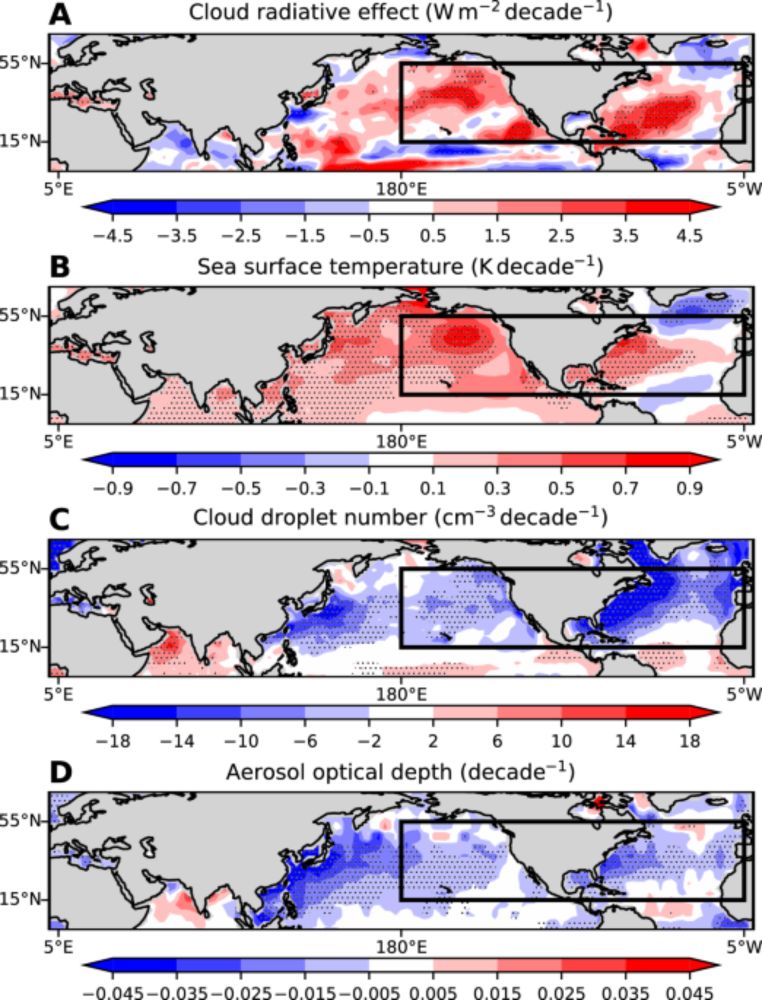2️⃣ We find that the upper-atmospheric circulation trendsconsist of at least two regional responses, with wave patterns over the US-Atlantic and Eurasia sectors. These waves are preceeded by distinct SST and OLR anomalies three weeks prior, yet these teleconnections are missing in CMIP6.
2️⃣ We find that the upper-atmospheric circulation trendsconsist of at least two regional responses, with wave patterns over the US-Atlantic and Eurasia sectors. These waves are preceeded by distinct SST and OLR anomalies three weeks prior, yet these teleconnections are missing in CMIP6.
1️⃣ Over the past decades, parts of the Northern Hemisphere midlatitudes have shown strong summertime changes in upper-atmospheric circulation and temperature extremes. Concerningly, some of these observed trends fall outside of historical CMIP6 simulations.
1️⃣ Over the past decades, parts of the Northern Hemisphere midlatitudes have shown strong summertime changes in upper-atmospheric circulation and temperature extremes. Concerningly, some of these observed trends fall outside of historical CMIP6 simulations.
Led by our regular partner @ifca.es.
➡️ More: predictia.es/en/blog/2025...

Led by our regular partner @ifca.es.
➡️ More: predictia.es/en/blog/2025...
Frontiers
www.frontiersin.org/journals/cli...

Frontiers
www.frontiersin.org/journals/cli...
journals.ametsoc.org/view/journal...
journals.ametsoc.org/view/journal...
Using #CMIP6 large ensembles, we find that most climate models project an increase in #ENSO frequency and intensity under anthropogenic #warming — driven by a shift toward Eastern Pacific El Niño pattern and amplified variability overall.
🌎 Read: doi.org/10.1029/2025...

Using #CMIP6 large ensembles, we find that most climate models project an increase in #ENSO frequency and intensity under anthropogenic #warming — driven by a shift toward Eastern Pacific El Niño pattern and amplified variability overall.
🌎 Read: doi.org/10.1029/2025...

->Nature | More from Lil Dr Glen EcoChat at BigEarthData.ai

Frontiers
www.frontiersin.org/journals/cli...

Frontiers
www.frontiersin.org/journals/cli...
Preprint: egusphere.copernicus.org/preprints/20...

Preprint: egusphere.copernicus.org/preprints/20...



Much more in observations than in CMIP6 climate models!:
1/

Much more in observations than in CMIP6 climate models!:
1/
www.nature.com/articles/s44...
1/

www.nature.com/articles/s44...
1/
1- The high end is based on the SSP585 scenario which was the only one available until 2300 in CMIP6, but according to the reduced-complexity models used in IPCC-AR6, the SSP370 scenario should also cross the limit beyond which most ice shelves become non-viable.

1- The high end is based on the SSP585 scenario which was the only one available until 2300 in CMIP6, but according to the reduced-complexity models used in IPCC-AR6, the SSP370 scenario should also cross the limit beyond which most ice shelves become non-viable.
🚫 Sanctions
💸 Inability to mobilise sufficient investment for development
🌡️ Effects of thawing permafrost threaten existing infrastructure

🚫 Sanctions
💸 Inability to mobilise sufficient investment for development
🌡️ Effects of thawing permafrost threaten existing infrastructure
www.frontiersin.org/journals/mar...

www.frontiersin.org/journals/mar...

